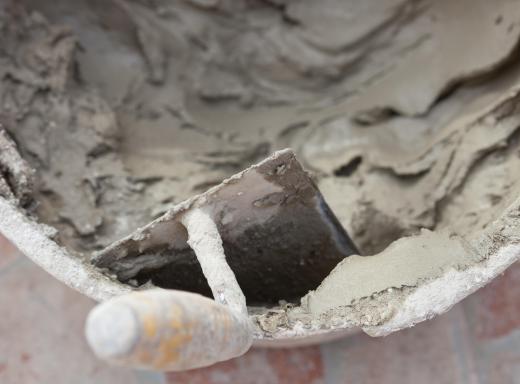Chimney mortar is a type of mortar which is designed to be used in chimneys. The process of applying mortar to a new chimney is known as pointing, while repairs are known as repointing. A related process, tuckpointing, involves the use of two contrasting colors of mortar to create the illusion of a very fine joint. Many hardware stores sell chimney mortar and can order specialty products by request.
Like other types of mortar, chimney mortar is an adhesive product which is designed to hold pieces of masonry such as bricks or rocks together. In addition to acting as an adhesive, chimney mortar must also be somewhat heat resistant so that it will not be damaged by high temperatures in the chimney. The mortar keeps the chimney stable and prevents water from penetrating into the chimney and the surrounding structure. Chimney mortar is sold as a dry powder which must be mixed by the user when it is needed.

Repointing is often regularly recommended for brick and stone chimneys. If mortar is allowed to decay, it can destablize the chimney, potentially creating a dangerous situation. As mortar cracks and breaks down, it also admits water, which can create water damage, promote the growth of mold, and allow bricks to crack from stress. Chimneys should be regularly inspected from top to bottom for signs of damage to the mortar, and repointed promptly when damage is identified.
If caught early, damage to chimney mortar can be repaired by a homeowner, working in an day or weekend to carefully remove old mortar section by section and replace it with freshly mixed chimney mortar. It is best to do this when the chimney will not be used in the near future, allowing the mortar plenty of time to cure. Ideally, a month should go by, although specific products may have more particular recommendations.
If mortar is badly damaged, bricks are cracked or missing, or the chimney appears to be listing or sagging, it is not safe to perform repointing as a do it yourself project. A professional should be brought in to determine whether or not the chimney can or should be salvaged, and to do the work. It may be necessary to demolish and rebuild the chimney if it is badly damaged. People who attempt to fix unstable chimneys themselves could be at risk of causing a chimney collapse, which could cause severe injuries and/or property damage.
Ever since she began contributing to the site several years ago, Mary has embraced the exciting challenge of being a About Mechanics researcher and writer. Mary has a liberal arts degree from Goddard College and spends her free time reading, cooking, and exploring the great outdoors.

